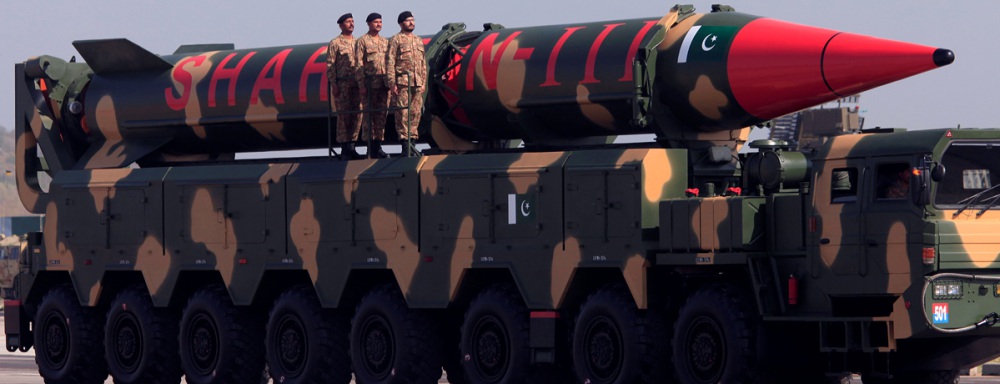
Jeffrey Lewis
Director of the East Asia Nonproliferation Program, The James Martin Center for Nonproliferation Studies
How close did India and Pakistan come to nuclear war in February 2019? After a suicide attack in Kashmir that killed 46 policemen, India conducted an airstrike against what it called a “terrorist training camp” in Balakot, Pakistan.
The crisis seemed on the verge of spiraling out of control after Pakistan shot down an Indian fighter jet. 1
According to a number of reports, Indian Prime Minister Narendra Modi seriously considered a missile strike in the event that Pakistan did not return the pilot. 2 The accounts vary—was it six missiles? Nine? Twelve? Or was it all a bluff, a threat upon which Modi never intended to follow through?
For his part, Modi has repeatedly emphasized that the threat was real and that had Pakistan not returned the pilot, he was prepared to commit what he called “a night of murder.” 3
For their part, Pakistani officials also claim the threat was real and that, had India launched the missiles, Prime Minister Imran Khan was prepared to respond “three times over” to any Indian strike. 4
As it turned out, the pilot was released and the crisis ebbed, another in a recurring series of crises in South Asia. War scares and nuclear brinkmanship also fueled the Cold War between the United States and the Soviet Union. The world held its breath as leaders squared off over Berlin in 1961 and Cuba in 1962, and as relations collapsed into the War Scare of 1983. Historians still debate how serious each of these crises really were. After all, while each side engaged in nuclear brinksmanship, the two superpowers always pulled back in time. There exists today a kind of confident hindsight that everything was destined to work out, a confidence that would have surprised those who lived through these scares. A similar confidence seems to exist that nuclear crises in South Asia, like their Cold War analogues, are not as frightening as they seem. Perhaps, people say, we exaggerated the danger in February, just as we exaggerated all the other dangers through which we have passed safely.
Many of us, though, remember the Cold War as terrifying. And many of us find that new historical information has done little to reassure that past crises were destined to end well. Robert McNamara recalled learning near the end of his life that, contrary to what he and other officials believed, that there were already Soviet nuclear weapons in Cuba in 1962. McNamara always thought the crisis had been dangerous, but he had not realized that an invasion almost certainly would have met with a nuclear response that could have escalated out of control. He thought he knew where the red lines were that October. He was wrong. McNamara was visibly shaken after learning this at a conference with Fidel Castro in 1992, later telling a reporter that the revelation had been “horrifying.” 5
Kennedy and McNamara, Khrushchev and Castro, like all leaders, were fallible. They made mistakes. They believed things that later turned out not to be true. In other words, they were human. So are Narendra Modi and Imran Khan.
One advantage that Kennedy and Khrushchev had was time. The Cuban Missile Crisis played out over thirteen days. We may take comfort from the fact that the United States and the Soviet Union always pulled back from the brink before it was too late – but they had the time to do so. Of course, they did not feel that they had time. Under the most demanding Cold War scenarios, the President had to be able to make a life-or-death decision about launching nuclear weapons in just a few minutes. This tight timeline was determined by the flight times of U.S. and Soviet intercontinental ballistic missiles (ICBMs) – it would take about thirty minutes for a Soviet ICBM to reach the United States. In the most extreme scenario—in which a missile from a submarine is launched on a low or “depressed” trajectory—the missile would take about ten minutes to reach the United States. 6
In South Asia, Modi and Khan will have far less time to make such a decision. A nuclear-armed Shaheen missile fired from inside Pakistan would arrive in New Delhi in about seven minutes. India’s newest short-range ballistic missile, the Pralay, would strike Islamabad in less than six minutes. Missiles fired on a depressed trajectory could reduce these flight times further. It is extremely unlikely that warning of a missile launch would reach either Prime Minister before the missile did.
In practice, an attacker is far more likely to succeed by going first, attempting to destroy the enemy’s nuclear forces before they can be dispersed. India, in particular, may feel compelled to strike Pakistan while Pakistan’s missiles are still in their garrisons – either striking the missile launchers themselves or, more likely, attempting to kill Pakistan’s political leadership before it can issue orders to disperse, let alone to retaliate. Scholars Christopher Clary and Vipin Narang have noted the signs in Indian discourse of what they call a “flirtation with preemptive counterforce,” warning that it could drive Pakistan to respond in ways that accelerate the regional arms race and undermine crisis stability. 7
The possibility that military plans could drive a crisis faster than leaders can manage is a classic concern. Barbara Tuchman dramatized the problem that is the tyranny of competing mobilization schedules in her 1962 Pulitzer-prize winning book about the outbreak of World War I, The Guns of August. Historians now dispute Tuchman’s view that the headlong rush to war was driven primarily by rigid mobilization requirements, but the book’s popularity undoubtedly owed to the fact that it was a parable for the nuclear age. Published in 1962, the book had a tremendous impact on President John F. Kennedy, who worried that he might be dragged into a war in a similar fashion. The book weighed on him during the Cuban Missile Crisis. “I am not going to follow a course,” he told his brother Robert, “which will allow anyone to write a comparable book about this time, The Missiles of October.” 8
One wonders whether current leaders in South Asia will be as cautious or just plain lucky as Kennedy. Many past crises in South Asia have led to the development of confidence building measures between India and Pakistan, including a notification regime for ballistic missile tests and multiple hotlines to connect military and political leaders. But these measures do not address the drift toward military strategies that emphasize offensive options. Many Indian scholars and experts have rejected the idea that India is moving toward a preemptive strategy, arguing that Clary and Narang have “misinterpreted” and “cherry-picked” evidence. 9 Clary and Narang’s arguments seem persuasive, but the possibility of such a fundamental dispute over India’s basic approach to deterrence and defense illustrates the need to strengthen confidence building measures.
There is little evidence, however, that Indian and Pakistani leaders see much of a problem. Not only did Modi campaign on his handling of the crisis and his willingness to commit a “night of murder,” he also promised to strip Kashmir of its semi-autonomous status. He has now taken that step, prompting what may begin yet another cycle of violence in South Asia. 10 Modi and Khan probably believe that their handling of past crises has been deft, but we now know that even the best American and Soviet leaders during the Cold War made serious mistakes. Like Kennedy and Khrushchev, Modi and Khan may be confident they can approach the brink of nuclear catastrophe, but pull back in time. Their success may depend on whether they realize how close that edge really is.
Sign up for our newsletter to get the latest on nuclear and biological threats.
There is a critical need for a global diplomatic approach to address growing cyber risks, including, where possible, through cooperation between the United States and Russia.
“The bottom line is that the countries and areas with the greatest responsibility for protecting the world from a catastrophic act of nuclear terrorism are derelict in their duty,” the 2023 NTI Index reports.
Christopher Nolan's Oppenheimer is the most high-profile film about nuclear weapons ever made.



